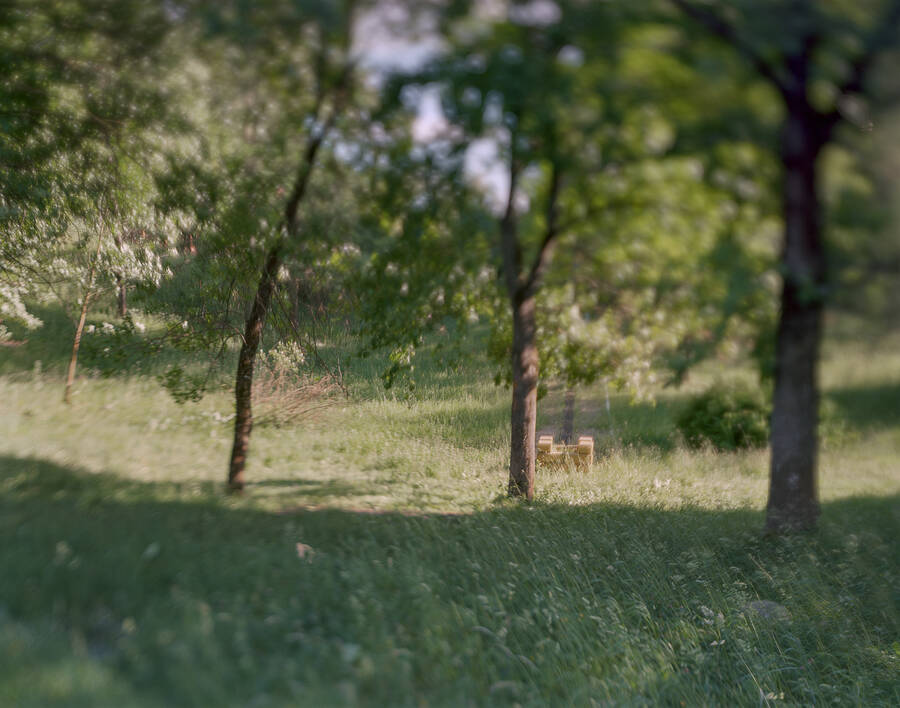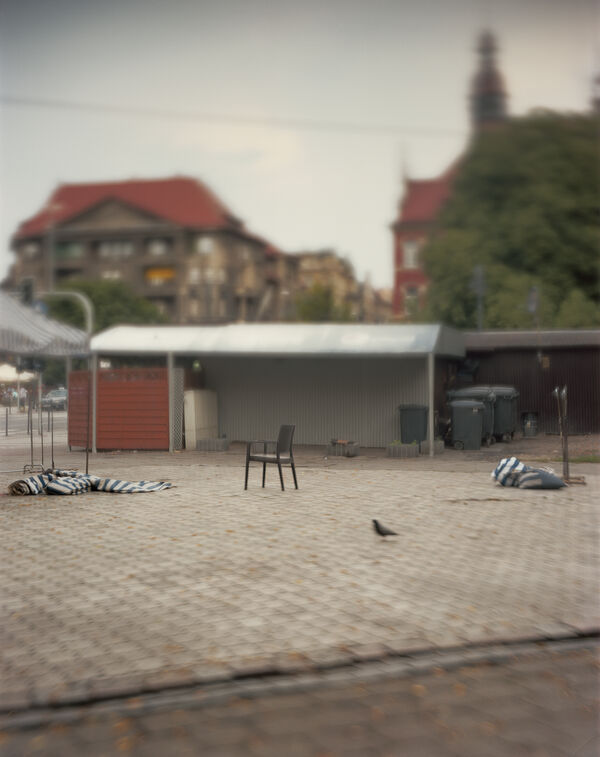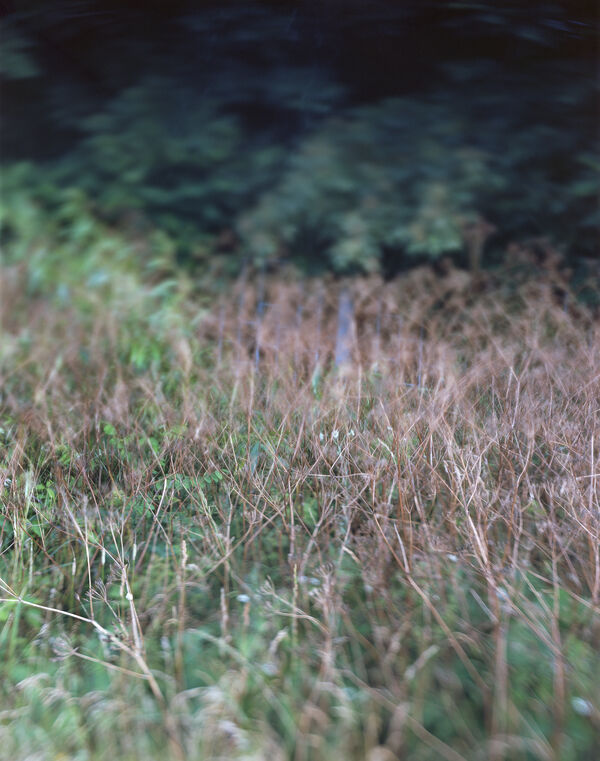Should the Heart Make a Stone of Itself?
An interview with the photographer Jason Francisco.

Killing ground of the Jews of Mir, Belarus, 2018.
(This article originally appeared in the Jewish Currents email newsletter; subscribe here!)
There is no deficit of contemporary photography that tries to capture the destruction of the Holocaust. Often that work relies on a limited set of tropes that metonymize the unspeakable horror: barbed wire, train tracks, cement-gray skies, wooden barracks. These now-familiar representations constrict the viewer’s experience, encouraging us to scan the image, which directs us to look where we already know to look, for what we already know we will find. Such pictures answer questions rather than open them. The artist Jason Francisco diverges from the conventions of this genre. In choosing sites to photograph, he seeks out locations whose histories of Holocaust violence are little-known, places whose meanings have not been fixed by the semantic heft of monument. His pictures—their unexpected beauty, surprising softness, and unlikely points of focus—make space for quieter, fuller forms of encounter. Viewed in aggregate, Jason’s images gesture to the simultaneously quotidian and charged nature of these places, and, by extension, ask the viewer to consider the palimpsest of history in all places.
It was Jason’s tendency toward complexity that first led me to seek out a connection with him in 2016. I was at work on a project about Holocaust commemoration in Poland when I read an essay he’d written about the Polin Museum in Warsaw. I was struck by its incisive critique and simultaneous generosity, and I wrote to Jason to say so. We began a correspondence that ultimately became a deep and lasting friendship. When our research trips to Europe overlapped, Jason and I sometimes traveled together in Poland and Lithuania, where I got to see his photographic process in action. In a lush meadow that was also an unmarked cemetery, or in the ruins of a shul that was now a storage depot, or on a narrow street that had at one time been some site of Jewish life or Jewish death, I would watch Jason peer into an antique camera, his head and shoulders concealed by a patterned cloth. Those images—ethereal glimpses of the afterlife of mostly overlooked sites where the Nazi genocide occurred—have been collected alongside essays and notes in a powerful new book, Alive and Destroyed, published by Daylight Books in December.
Alive and Destroyed represents over a decade of Jason’s photographs, but he has studied and made work about the Holocaust for much longer. Since 1990, Jason has worked extensively in Central and Eastern Europe, where he has both cultivated his own artistic practice and nourished creative communities. He is the author of several books—including Far from Zion: Jews, Diaspora, Memory and The Camp in its Afterlives—as well as numerous limited edition photobooks, installations, films, reportages, and essays. Together with two other friends, we co-founded FestivALT, an annual festival of experimental Jewish art in Kraków, Poland. I spoke with Jason about inheriting genocide, the quagmires of “Jewish art,” and the uses and misuses of Holocaust memory. This conversation has been edited for length and clarity.
Maia Ipp: How did you think about approaching the Holocaust as a subject in Alive and Destroyed?
Jason Francisco: In simple terms, it’s a book about inheriting genocide—the imperative to remember as it meets the struggle to remember. The project is the result of two contradictory urges. The documentary urge reflects the impulse to go out into the world to see things directly. And I did this: For over a decade I worked in hundreds of places where the events that we collectively call the Holocaust occurred, from Riga in the north to Bucharest in the south, Berlin in the west to Kharkiv in the east. On the other hand, a conceptualist urge bends the process of seeing toward the practice of contemplating, and ultimately this is what I understand these photographs to do. They are themselves sites of contemplation, made through encounter with the earth of genocide. The contemplative experience pivots not on the convergence of seeing and knowing, which anchors conventional documentary work, but on the reverse, the discrepancies between them, the generative truth in lack.

Site of the destroyed Great Synagogue of Katowice, Poland, 2016.
MI: One might think that these discrepancies point to the lostness of the past—to the deadness of the dead—but your work reminds me that the practice of contemplation is precisely where the present enters. Alive and Destroyed is productively preoccupied with examining how the past enters the present, and vice versa. You write, “When we speak of the Holocaust today, we speak of two things: the Holocaust as history, which belongs to the past, and the Holocaust as culture, which belongs very much to the present.” What do you see as the dominant mode of “Holocaust culture” in Jewish life today?
JF: Objectification. In contemporary Jewish life, the Holocaust is often treated as a static object of collective consciousness that is to be honored, gestured at, invoked—from the distance we are told is the inevitable consequence of time passing. Contemporary audiences tend to expect that art that engages with the Holocaust will offer the pretense of control: slogans or exhortations or, in the better cases, stories. And then there are the common pitfalls of making work about the Holocaust; there is so much work that is mawkish, cloying, repetitive, preachy, ultimately kitschy (though not self-aware of that fact), often tending toward the monumental. Or, conversely, there is work that is explicitly kitschy—like Zbigniew Libera’s “Lego Concentration Camp”—and de-monumentalized, like Jochen Gerz and Esther Shalev-Gerz’s “Monument against Fascism,” which was performatively disappeared to form what the artists termed a “Gegen-Denkmal” (counter-monument). The solemn versus kitsch and monument versus anti-monument binaries seem to me spent, arm-wrestled to exhaustion.
And then there are the vexed politics of Holocaust memory. Growing up as a Jew in the US, I was aware of a link forged between the Holocaust and Zionist narratives of Israel as redemption. As a young adult I avoided the Holocaust partly out of resistance to this specifically Jewish instrumentalization.
MI: You write: “My reasons for undertaking this work have nothing to do with asserting the Holocaust’s primacy among historical crimes, or its place in a ranking of miseries. I do not stand with those Jews who understand the catchphrase ‘Never Again’ [merely] to mean ‘Never Again to us.’” What alternative do you hope to assert?
JF: I hope, first and foremost, to turn what I see as the stasis of memory toward what I perceive as the much more dynamic practice of remembrance. The difference is vital. Memory, for me, is preoccupied with the accuracy of representations of the past, with the past on its own terms. It lends itself to nationalisms, which I oppose, and competitive victimhood. Remembrance, on the other hand, is concerned with the adequacy of the imagination for the past. Remembrance attends to the past on the terms of the ongoing present.
This commitment to remembrance guided my formal choices inAlive and Destroyed. I originally intended, for example, to present detailed texts about each place alongside each photograph, and I wrote many of them. Ultimately, though, I came to see such a gesture as a mechanism of false stability. These texts weigh the scale on the side of knowing, when in fact I want the photographs to find balance between knowing and not knowing. By pulling back from the informational impulse, I don’t mean to disavow it. Rather I mean to release the clenching mental states that information favors and to invite other states of mind—call them speculative states: associative, dreamful—that are essential for remembrance to remain vital. After all, remembrance is a live process and belongs to the living. Even as the heart may crave stones and monuments to give duration to grief, faced with the task of remembering, should the heart make a stone of itself?

Massacre site and mass grave of the Jews of Liuboml, Ukraine, 2017.
MI: How did your commitment to the liveness of remembrance inform your choice of technology in this project?
JF: To create the images that make up Alive and Destroyed, I used a large-format camera on a tripod, as well as a digital Leica handheld . Photography can be boiled down to two core demands, as my teacher Joel Leivick used to say: where to point the camera and when to release the shutter. Each of these questions turns out to be intricate. The Leica, which is a sketching camera (by which I mean one used to work out ideas quickly), helps me to induce the practice of seeing, and to find what I call the place within the place—where exactly in the wide sphere of space the camera should go.
When I set up the view camera, things slow down. The camera is heavy and cumbersome. A lens throws light through a bellows onto a ground glass, which you generally can’t see too well unless you put a cloth over your head. The glowing image on the ground glass—which appears upside down and backwards, pure and uncorrected—has an almost mesmerizing presence, and in this way the camera itself induces a kind of contemplative experience. Beyond this, the view camera is singular in the control it offers the photographer—allowing you not only to change the shapes of various components of the image as they appear on the ground glass but also to create planes of focus in nearly any direction. Ultimately the view camera assumes the role not of a tool but a partner. It moves the mind to be able to see things it could not otherwise see.
MI: In your prologue, you translate the Yiddish poem “Six Lines” by Aaron Zeitlin seven times. Each translation is slightly different. What is the role of iteration in your work?
JF: Iteration is the best way I know to push distinct states of awareness toward a condition of simultaneity. Zeitlin’s poem is not any one of these translations, but all of them and more. If I could write the translations on top of one another in different shades of ink, and somehow they would remain legible while combining and recombining to form the whole, I would have done it. Maybe this is a photographer’s way of seeing a poem: a chatoyant thing turning in the mind and the heart. I made the photographs likewise to have a processual quality legible in them.

The former center of Jewish religious life in Zolochiv, Ukraine, 2017.
MI: A painful, resonant line from the Zeitlin, in your translation: “Who needs a poem anyway, especially one in Yiddish?” How do you relate to the Jewishness of your material?
JF: I am a Jew and an artist and I work on Jewish topics and questions, but I don’t think I practice something called “Jewish art,” and I do not make the work specifically for Jewish audiences. I don’t see this as disclaiming Jewishness, but rather disclaiming Jewish insularity. To make work about the Holocaust as a Jew primarily for Jewish audiences would, for me, resonate a little too uncomfortably with the default status of Holocaust remembrance in the places where the genocide actually happened—where it is mostly, and sometimes merely, a Jewish concern. We cannot forget that the Nazi war against the Jews was fundamentally anti-human. It was a war to obliterate human life because it exists at all. The Russian Jewish historian Mikhail Gefter put the point elegantly when he said that genocide is never just against someone, but always against everyone.
MI: I see the truth in what you’re saying about making art as a Jew for other Jews. At the same time, I think of how much I’ve been moved by writers working in idioms specific to cultures totally apart from those I’ve known personally. If they had been writing to me, an outsider, I don’t think the work would have been as bold, as sharp. How do you create work that is specific but not parochial?
JF: I think you’re right to suggest that universalist ambition can be distinctly bland. Sham transcendency is no better than bad parochialism. And you’re right, too, to suggest that there is a hidden surplus to specificity, which turns out to invite access beyond its apparent limits. I once heard the poet Natasha Trethewey define poetry as the discovery that you are saying something other than what you mean when you say exactly what you mean. Something like this is how I understand the sensation of entry into that which is foreign.
In my case, the way to non-parochial specificity has been to wrestle with the complications of in situ remembrance. By considering the particularities of a given place, I hope to allow the contest of insight and incomprehension involved in Holocaust remembrance to be just that: an unfinished specificity, an exactitude without essence.
Maia Ipp was one of the four editors who relaunched Jewish Currents in 2018. She is a writer of fiction and cultural criticism and the artistic director of the New Jewish Culture Fellowship. In 2020–21 she was a creative writing teaching fellow at Columbia University, where she also held a De Alba fiction fellowship.
